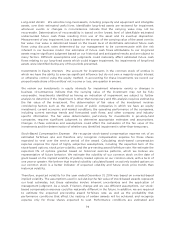Yahoo 2014 Annual Report Download - page 81
Download and view the complete annual report
Please find page 81 of the 2014 Yahoo annual report below. You can navigate through the pages in the report by either clicking on the pages listed below, or by using the keyword search tool below to find specific information within the annual report.uncertainties based on estimates of whether, and the extent to which, additional taxes will be due.
These liabilities are established when we believe that certain positions might be challenged despite
our belief that our tax return positions are in accordance with applicable tax laws. We adjust these
liabilities in light of changing facts and circumstances, such as the closing of a tax audit, new tax
legislation, developments in case law or interactions with the tax authorities. To the extent that the
final tax outcome of these matters is different than the amounts recorded, such differences will affect
the provision for income taxes in the period in which such determination is made. The provision for
income taxes includes the effect of liability provisions and changes to reserves that are considered
appropriate, as well as the related net interest and penalties.
We record a valuation allowance against certain of our deferred income tax assets if it is more likely
than not that those assets will not be realized. In evaluating our ability to realize our deferred income
tax assets we consider all available positive and negative evidence, including our operating results,
ongoing tax planning, and forecasts of future taxable income on a jurisdiction by jurisdiction basis. In
the event we were to determine that we would be able to realize these deferred income tax assets in
the future, we would make an adjustment to the valuation allowance, which would reduce the
provision for income taxes.
Goodwill. Goodwill is not amortized but is evaluated for impairment annually or whenever we
identify certain triggering events or circumstances that would more likely than not reduce the
estimated fair value of a reporting unit below its carrying amount. Events or circumstances that
might indicate an interim evaluation is warranted include, among other things, unexpected adverse
business conditions, regulatory changes, loss of key personnel and reporting unit and macro-
economic factors. Goodwill is tested for impairment at the reporting unit level, which is one level
below our operating segments.
We identified U.S. & Canada, Latin America, and Tumblr as the reporting units below the Americas
operating segment; Europe and Middle East as the reporting units below the EMEA operating
segment; and Taiwan, Hong Kong, Australia & New Zealand, India & Southeast Asia as the reporting
units below the Asia Pacific operating segment. These operating segments are the same as our
reportable segments.
We test for goodwill impairment annually as of October 31 each year or more frequently if there is a
triggering event. To test for impairment, we use the two-step quantitative test. The first step of the
quantitative test involves comparing the estimated fair value of our reporting units to their carrying
values, including goodwill. If the carrying value of the reporting unit exceeds its fair value, the second
step of the quantitative test is performed by comparing the carrying value of the goodwill in the
reporting unit to its implied fair value. An impairment charge is recognized for the excess of the
carrying value of goodwill over its implied fair value.
The estimated fair values of the U.S. & Canada, Latin America, Europe, Taiwan, Hong Kong, and
Australia & New Zealand reporting units were estimated using an average of a market approach and
an income approach as this combination is deemed to be the most indicative of our estimated fair
value in an orderly transaction between market participants and is consistent with the methodology
used for the goodwill impairment test in prior years. In addition, we ensure that the estimated fair
values under these two approaches are comparable with each other. The fair value of the Tumblr
reporting unit was estimated using the market approach and was deemed to be the most indicative
of our estimated fair value in an orderly transaction between market participants. The estimated fair
values of the Middle East and India & Southeast Asia reporting units were determined using the
income approach as the market approach yielded a much higher fair value and was not comparable
with the income approach. Under the market approach, we utilize publicly-traded comparable
company information to determine revenue and earnings multiples that are used to value our
reporting units adjusted for an estimated control premium. Under the income approach, we
77
























